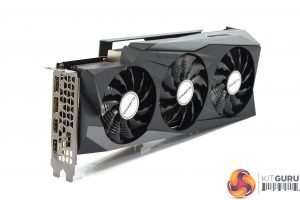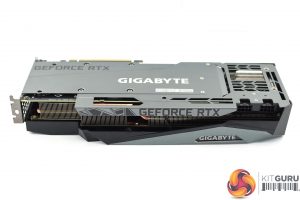Next is the Gigabyte RTX 3080 Ti Gaming OC. This ships in a very familiar-looking box, with Gigabyte's robotic eye design taking up the front.
Inside, we get a warranty note and a quick start guide.
As for the card itself, while we haven't reviewed the RTX 3090 Gaming OC, we have looked at the likes of the RTX 3070 Gaming OC and it is clear these two cards are from the same family. Gigabyte uses a black shroud with some grey and silver accents, while it's triple-fan layout is also familiar. The fan closest to the I/O bracket measures 80mm, while the other two measure 90mm. As always, this cooler uses Gigabyte’s Alternate Spinning feature, where the central fan spins in reverse relative to the outer two, which should reduce turbulence and increase overall pressure down onto the heatsink itself.
In terms of sizing, this is a very hefty card. It measures 320 x 129 x 55mm, making it a ‘2.7' slot thickness, though in reality you will need three free expansion slots.
As for the backplate, it is again identical to other Gaming OC cards we have seen. That means it is a full-length metal design, with a large cut-out at the end of the card which Gigabyte calls ‘Screen Cooling'. The Gigabyte logo is printed centrally, in a white font.
We can also note a dual-BIOS switch positioned on the front side of the card, with the default being the OC BIOS (370W power limit), while a Silent BIOS (350W power limit) is also available.
Two 8-pin power inputs are required, while we find 3x DisplayPort 1.4 and 2x HDMI 2.1 display outputs.
Taking a look at the PCB, Gigabyte is using a total of 19 phases, likely split with 15 for the GPU and 4 for the memory. The MOSFETs used are Alpha & Omega AOZ5332QI, rated for 50A continuous current. We can also note two UPI uP9512R controllers and one UPI uP9511R controller, as well as two UPI uS5650Q controllers.
Memory is supplied by Micron, with the model code 0YT77D8BWW.
As for the cooler, Gigabyte uses two finstacks which are connected by a total of six copper heatpipes. A central copper baseplate is used to make contract with both the GPU and the memory, while some additional plates contact with the VRM via thermal pads.
The backplate does also use thermal pads to contact with the back of the PCB, which can help reduce heat slightly.
 KitGuru KitGuru.net – Tech News | Hardware News | Hardware Reviews | IOS | Mobile | Gaming | Graphics Cards
KitGuru KitGuru.net – Tech News | Hardware News | Hardware Reviews | IOS | Mobile | Gaming | Graphics Cards





















